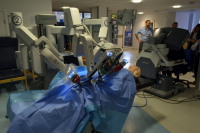








The first robotic system was introduced into the medical world in 1985. Dr. Yik San Kwoh of the Long Beach Memorial Medical Center used a robotic arm to direct a needle into his patients brain. Dr. Kwoh said about the surgery, ”The robotic arm is safer, faster and far less invasive than current surgical procedures.”
Since then, robotics have played key active roles in the fields of surgery, rehabilitation and diagnostics.
Surgery, in specific, is an area where robots are changing the way healthcare is delivered. Early technologies have mostly been aimed at assisting the surgeon, leading to a more efficient surgery.
Robots in the Operating Room
Perhaps the most well-known Israeli medical innovation using robotics is Mazor’s Renaissance.
The Renaissance gives the surgeon the opportunity to map out the surgery prior to the procedure. The system then guides the surgeon’s tools during the procedure, enabling accurate incisions and placements of implants.
Providing Surgeons a Better View During Surgery
Israel’s Medical Surgery Technologies (MST), OurCrowd’s newest portfolio company, acknowledges the need to provide automated surgical assistance , leaving a seasoned surgeon in complete control.
MST’s FDA-approved robotic vision system replaces the medical assistant who historically handled the video camera during laparoscopic surgeries. Surgeons don’t have the three hands needed to perform accurate laparoscopic surgery and using assistants means more time in the OR and a doctor who occasionally suffers from dizziness and vertigo as a result of a shaky video feed.
MST’s system gives the surgeon complete control of all of his tools by using a robotic vision system that automatically follows the surgeon’s moves, ensuring the camera is always in place. Just like a plane needs a pilot, so too, the operating room needs a surgeon.
Bringing Israeli flight simulation to the OR
Another Israeli company integrating technology into the operating room is Surgical Theater, part of the OurCrowd startup portfolio. Dubbed “the flight simulator of the brain,” Surgical Theater’s SRP (surgical rehearsal platform) uses advanced MRI/CT imaging to power a pre-surgery rehearsal on a 3D image of the patient’s brain. Another feature of Surgical Theater is the collaborative theater, which allows surgeons all over the world to conduct joint simulations of neurological procedures.
In future
Robots may not have taken over the world, but they have begun to save lives. Some robotic systems are doing just that by assisting, not replacing, surgeons via improved imaging and rehearsal. Innovative companies like MST are enhancing the quality of medical care for patients worldwide.